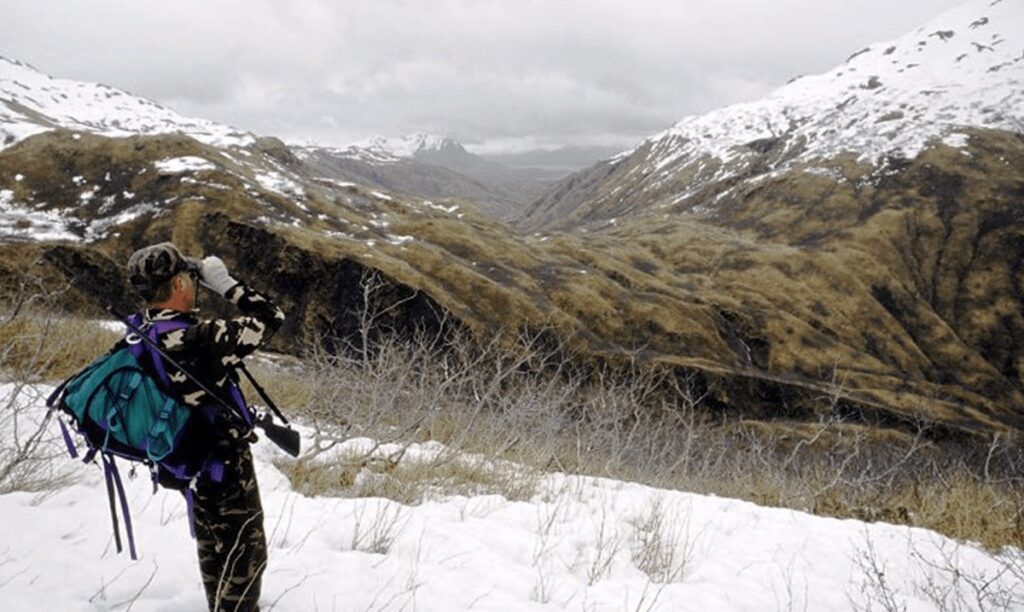
Hunting the Mountain Grizzly
By Bob Robb
In the journals of the historic Lewis and Clark expedition, Meriwether Lewis spent much time describing encounters with the great “white bear,” as they called the grizzly. Lewis noted that these “cantankerous bears” were just as likely to attack man as leave him alone. Though great hunters, he wrote, the Native Americans would never intentionally take on a grizzly, armed as they were with nothing more than a spear or longbow. Instead, they would band together in groups of between six and 10, hoping to accomplish with sheer numbers what they could never do alone.
“When the Indians are about to go in quest of the ‘white bear,’ previous to their departure they paint themselves and perform all of those superstitious rites commonly observed when they are about to make war on a neighboring nation,” Lewis wrote. Obviously, these expert woodsmen had learned that when the quarry was an animal with the strength of a dozen men, the speed of a fast pony and the disposition of the devil himself, discretion was the better part of valor.
***
Ninety-Five Percent Boredom, Five-Percent Pure Terror
My first Alaska hunting trip occurred in the mid-1980s. I had licenses for the majestic caribou, the regal Dall’s sheep and a mountain grizzly. All my friends envied my sheep license, but deep inside I was more excited by the chance to hunt the grizzly bear. I had read several historical accounts of grizzlies, including the Lewis and Clark journals, and was spellbound by the seemingly impossible things men had seen these great bears do.
I took my first grizzly on that trip deep into the Wrangell Mountains, a large, dark-brown bear with long claws and a flawless hide. Legendary outfitter Terry Overly spotted the bear ambling up a drainage one September afternoon. The weather was postcard perfect, the tundra a brilliant kaleidoscope of colors set against a backdrop of cobalt sky and snow-capped peaks. We tied the horses off, climbed the 60-degree slope and fought through the alders, breathlessly coming into an open slide the same time the bear did, not 75 yards away. When he stood up on his hind legs, I calmly raised my rifle, took aim … and missed him by a mile. As he took off across the scree, I emptied the rifle, hitting him all three times through the chest as he raced into an alder thicket, where he expired.
It took a week for the adrenaline rush to wear off. The memories never will.
Hunting grizzly bears was once described to me as 95-percent boredom and five-percent pure terror. That’s a pretty fair assessment. The boredom part comes with simply trying to locate a bear. This can take a lot of time or no time at all, depending on the turn of the cards.
Unlike coastal brown bears, which concentrate on salmon streams in the fall and are relatively easy to find, interior bears are much more nomadic. A biologist once told me they can have a home range of as much as 50 square miles and may cover double-digit miles daily in search of food. This can make finding bears problematic. In years of a strong fall blueberry crop, grizzlies tend to congregate on mountains that have large expanses of berry bushes. They also dig roots. In spring, they tend to follow ungulate herds, preying heavily on newborn calves. Fresh grass shoots are a favored food in spring, too, on which the bears graze like cattle. At all times they’ll expend hundreds of calories to excavate a low-calorie ground squirrel or marmot, which must taste like chocolate to them. But while they have their preferences, these omnivores will eat just about anything, including plastic cans filed with gasoline left on remote air strips by bush pilots, and even your tent.
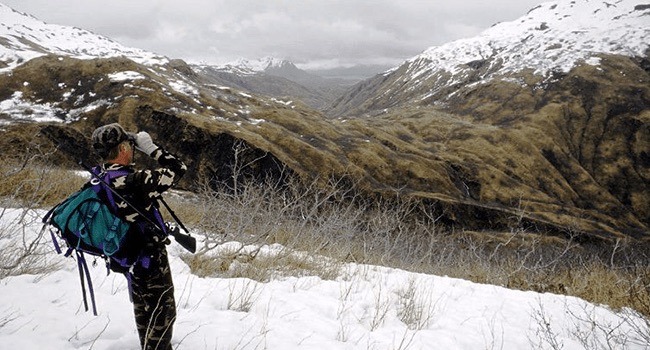
Rain or shine, glassing is the name of the game. Here’s the author glassing a big river drainage in western Alaska.
That said, the name of the game in interior grizzly hunting is glassing. When the weather’s good, it isn’t so bad. The wild country in which grizzlies thrive is the continent’s most stunning, and there’s always something to look at. When the weather turns sour and cold and wind-driven rain, sleet or snow eats its way under all your clothes, it’s hard to keep looking. And, yes, when there aren’t any bears to look at, boredom sets in. But stay at it long enough, and the chances are you’ll be rewarded by the sight of a bear working along the mountainside.
Seeing your first grizzly will never be forgotten, and it’s at that moment when the questions creep in. After all, a grizzly is a threatening animal, one that, together with the coastal brown bear and the polar bear, is the only really dangerous game animal in North America. Your palms become a little sweaty, your heart begins to race. You know that you’ve seen the bear and he hasn’t spotted you. You have a high-powered rifle, are with an experienced guide for backup and the wind is right. It shouldn’t be any different than moving in for a shot at a deer back home.
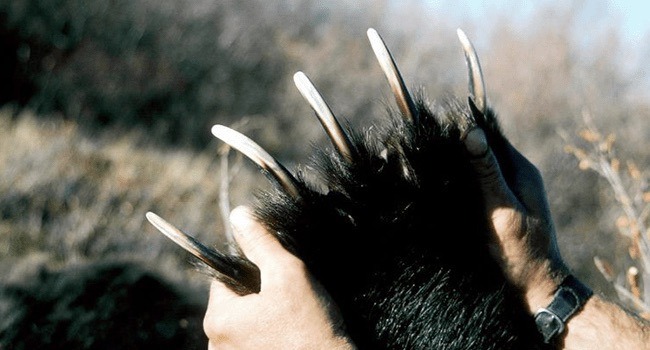
The biggest mountain grizzly the author ever shot had this fearsome front paw. How’d you like to be swatted with that?
And yet deep down inside you know that it is different. Even the best grizzly hunt can go wrong—and you’ve read all the stories about wounded bears in the alders, of bear attacks and maulings, of chance encounters won by a bear. Doubt creeps into your subconscious.
Spring Vs. Fall Seasons
Grizzlies can be hunted both spring and fall and there are advantages and disadvantages to each.
In spring, if you catch a bear soon after he leaves the den, the hide is unbelievably lush and magnificent. The trouble with spring hunting is the weather. A freak snowstorm and you’re out of business. Also, in spring, the bears move a lot as they look for food. Because their food sources are scattered, you have to cover a lot of ground yourself, both physically and with your optics.
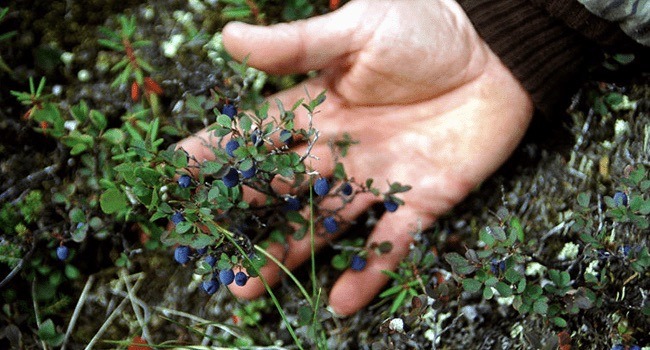
In fall, grizzlies will gorge on blueberries. Find the berries and the bears will be close.
In the fall, you try and find food sources and hang with them until you catch a roaming bear. Another advantage to fall seasons is that you can hunt grizzlies in combination with other species like Dall’s sheep, caribou and moose. Many bears are taken when the hunter is actually pursuing one of these other animals.
The Biggest Rifle is Not Necessarily the Best Rifle
It’s important to shoot the largest caliber rifle you can shoot well. It is much better to use a bit less rifle you are comfortable with than a heavy caliber that makes you flinch, because placing that first shot where you want it is the best insurance there is against potential trouble.
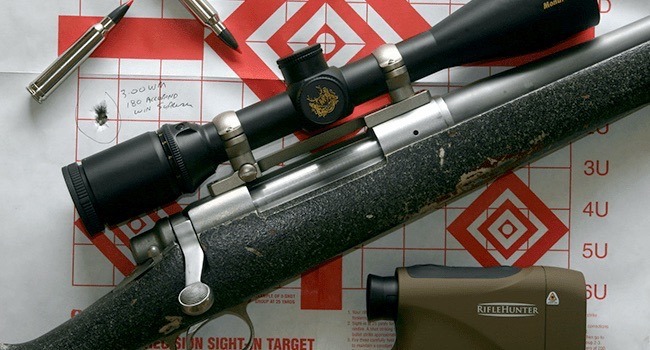
The .300 Win. Mag. loaded with a premium 180-grain bullet is an excellent choice for mountain grizzly bear hunting.
I’ve cleanly taken two 600-pound interior bears with a .280 Remington loaded with 160-grain Nosler Partition bullets. Cartridges in the .30-06/7mm magnum class are good minimums, with the .300 magnums better and the .338 Win. Mag. outstanding. My preferred grizzly gun today is a .300 Win. Mag. topped with a 2.5-10X scope and loaded with 180-grain premium-quality bullets.
Do You Need A Guide?
By law, nonresidents of both Alaska and Canada must hire a licensed outfitter to legally hunt grizzlies, the exception being that you can hunt with an Alaska resident who is a second-degree of kindred relative. That said, outfitted grizzly hunts are expensive, with costs running well into five figures depending on where and with whom you are hunting.
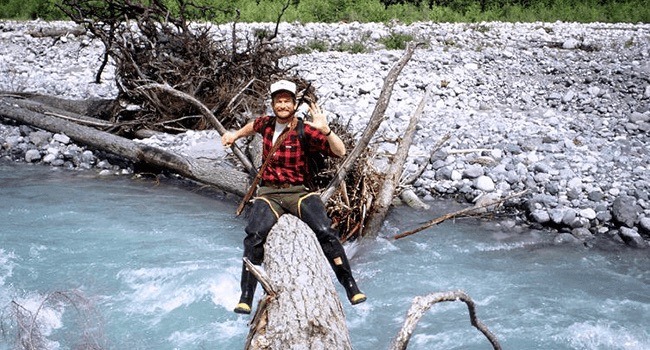
Mountain grizzlies live in some of North America’s most beautiful and challenging environments. Scooching across a raging river is part of the excitement for the author on a spring Alaska hunt.
What about Lower 48 hunting? When Lewis and Clark came through the neighborhood, the U.S. Fish & Wildlife Service (USFWS) estimates there was upwards of 60,000 grizzly bears living between the Pacific Ocean and Great Plains. Settlers shot them on sight, and in 1975, when it was estimated that only 180 to 220 of them were left in the Greater Yellowstone Ecosystem (GYE), grizzlies were listed as a threatened species and given federal protection under the Endangered Species Act in all states except Alaska.
Today, the recovery of the grizzly is easily one of the greatest wildlife conservation success stories of the last 100 years, so much so that the USFWS has maintained that, since 2007, the GYE grizzly population and its habitat have recovered enough that the bears could be placed under state management plans. Estimates show that the GYE grizzly population is over 700 today, a number well above agreed-upon recovery goals. They were removed from the endangered species list from 2007 to 2009, when rumblings of strictly limited hunting seasons began. Then, so did the lawsuits filed by animal rights activist groups, and so today no grizzly hunting is permitted in the Lower 48 states. The only grizzlies legally killed today are so-called “nuisance bears” killed by government sharpshooters or people—primarily deer and elk hunters—defending themselves against attacks. In 2019, for example, in Wyoming there were 22 grizzlies killed, and another 33 problem bears were trapped and moved.
To date, I have taken a half-dozen true mountain grizzlies. In my mind, they are the most magnificent big-game animal in North America. If you’re looking for adventure, find a worthy outfitter and pay the price—it will almost without doubt be worth far more than you dreamed it would be.
You may also be interested in:
Bear Den Study Demonstrates the Conservation Contributions of America’s Firearms Industry

